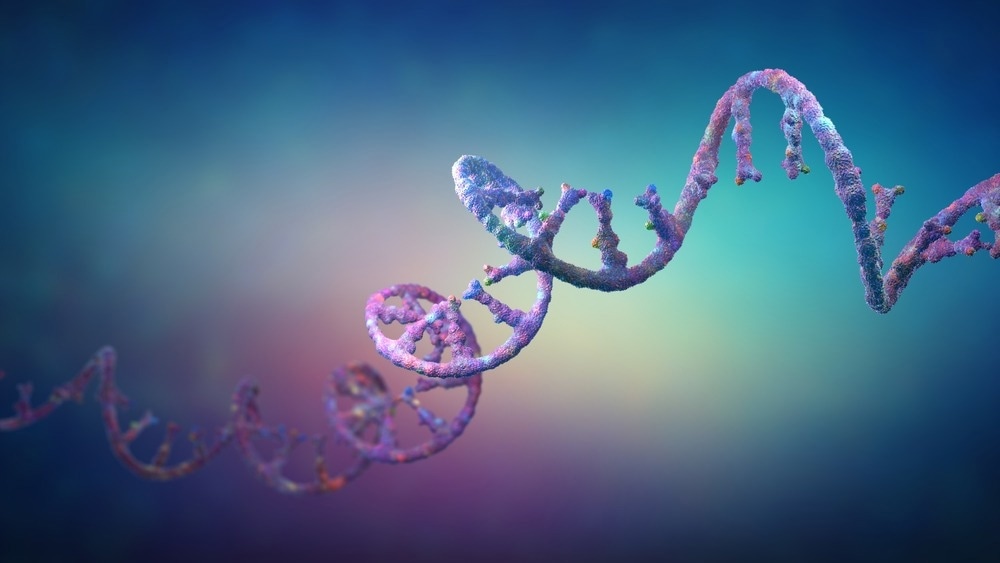Gold nanoparticles (AuNPs) have been commonly used in biomedical diagnostics because of their unique characteristic features, including high colloidal stability, prominent visible light absorption and scattering, a large surface area to volume ratio, and easy functionalization.

Study: Improved gold Nanoprobes for Detection of Single Nucleotide Polymorphisms. The Influence of size. Image Credit: Christoph Burgstedt/Shutterstock.com
A new Particle and Particle Systems Characterization study compared the properties of 20 nanometer and 35 nanometer spherical AuNPs, functionalized with a specific thiol-modified oligonucleotide, to develop an improved Au-nanoprobe for the detection of single nucleotide polymorphism (SNP) for lactose intolerance.
The Association Between SNP and Lactose Intolerance
SNPs are associated with several diseases, and their detection is extremely important but challenging. This is basically because SNP detection requires high sensitivity and expensive protocols.
Adult-type hypolactasia or lactose intolerance is a condition where an individual cannot digest significant amounts of lactose. This inability is genetically linked and is commonly found in the European population.
Lactose intolerance has been associated with 13910C/T (SNP), which is located in the MCM6 gene, found approximately 14 kb upstream of the lactase gene (LCT). The LCT gene is associated with the production of lactase enzyme, which degrades lactose. MCM6 gene mutation affects the function of LCT.
It was observed that individuals containing both copies of the T allele (C/T or T/T) at MCM6 could digest lactose. In contrast, those with no copy of the T allele (C/C) could not digest lactose.
Detection of SNP Using Au-Nanoprobes
AuNP has been considered a promising candidate for novel colorimetric assay to study biological samples, such as nucleic acids and proteins, due to their higher extinction coefficients for the plasmon band, which promotes the production of intense color.
AuNPs functionalized with single-stranded thiolated DNA served as an extraordinary nanoprobe for the colorimetric detection of specific DNA sequences. This method was based on a non-cross-linking approach. In 1991, a nanoprobe developed by the pioneering C.A. Mirkin research team used two different, single-stranded thiolated DNA probes. Due to stability issues, further advancement of this nanoprobe was hindered.
DNA can be detected easily using Au-nanoprobes based on the visible color change. This color change occurs with the addition of salt, which transforms Au-nanoprobes from a dispersed to aggregated state. However, in the case of SNPs, the mutated sample was partially hybridized with the probe’s oligos, which shielded the salts-induced aggregation. This event created an insignificant difference in the optical properties between positive and mutated samples, which caused visual detection impossible.
Several procedures have been developed to optimize the performance of similar AuNPs-based assays. For instance, the utilization of a spacer between the nucleotide and the thiol group has been recommended because it can prevent steric hindrance upon target hybridization. Although this approach improved DNA loading, it reduced the interaction between DNA bases and Au.
Improved Au-Nanoprobes for the Detection of SNP for Lactose Intolerance
It was assumed that alteration in the optical and aggregation properties of AuNPs could improve SNPs detection. These properties are highly sensitive to the size and shape of AuNPs. Larger-sized AuNPs exhibited better detection sensitivity due to their higher extinction coefficients. Additionally, lower AuNP curvatures enhanced the interaction with the target.
Here, a new Au nanoprobe was developed for SNPs detection, based on a comparative study using 20 nanometer and 35 nanometer AuNPs. Both the nanoprobes were functionalized with thiol-modified 20-mer oligonucleotide, which was entirely complementary to the DNA sequence of lactose intolerance (13910*C SNP) and moderately complementary to the DNA sequence of lactose tolerance (13910*T SNP).
Salt aging (SA) and the pH methods were used to functionalize 20 and 35 nanometer AuNPs with different molar concentrations of the thiol-modified 20-mer oligonucleotide. The pH method was favored because it led to the production of stable nanoprobes at low oligonucleotide: AuNPs ratios. Based on various analyses, the optimal functionalized ratio of 20 and 35 nanometer Au-nanoprobe was determined to be 150 and 1300, respectively.
Following the hybridization of Au nanoprobes with the DNA targets and control, their endurance to salt-induced aggregation was determined using UV/vis spectroscopy. After hybridization with totally complementary DNA (CC), positive samples exhibited no visible color change because Au nanoprobes became resistant to salt-induced aggregation. However, a prominent color change from red to blue was observed upon salt addition for control due to the formation of Au nanoprobes aggregate.
Limits of discrimination (LoD) for SNPs detection, using 35 nanometer and 20 nanometer Au-nanoprobes, exhibited similar detection limits using a 0.15 nmol·dm−3 nanoprobe concentration. However, this was not the case with 2.5 nmol·dm−3 nanoprobe concentration.
The overall findings indicated that the discrimination was more efficient for the 40-mer ssDNA targets, instead of larger 120-mer ssDNA targets. Interestingly, 35 nanometer Au nanoprobes permitted a reduction of 80% of gold and 48% of oligonucleotide used in the assay. Compared to 20 nanometer Au nanoprobes, 35 nanometer Au nanoprobes exhibited a higher difference between the complementary and mismatched DNA, which was independent of the length of the target. Hence, this nanoprobe was recommended to develop future low-cost detection assays.
Reference
Enea, M. et al. (2022) Improved gold Nanoprobes for Detection of Single Nucleotide Polymorphisms. The Influence of size. Particle and Particle Systems Characterization. https://onlinelibrary.wiley.com/doi/10.1002/ppsc.202200137
Disclaimer: The views expressed here are those of the author expressed in their private capacity and do not necessarily represent the views of AZoM.com Limited T/A AZoNetwork the owner and operator of this website. This disclaimer forms part of the Terms and conditions of use of this website.